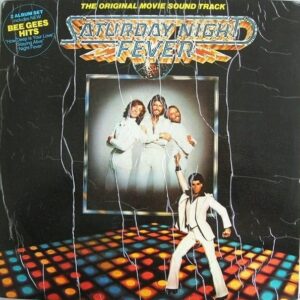Disco in Film & Television: From ‘Thank God It’s Friday’ to ‘Pose’
From the silver screen to the glow of television, disco’s energy has pulsed through visual culture with unforgettable force. Films and TV shows didn’t merely reflect the disco era, they mythologized it, reinforced its style, and sometimes redefined how the world perceived the movement. The dancefloor, already a stage for liberation, suddenly became a cinematic spectacle, reaching audiences who may never have set foot in a club.
Perhaps no film captured the public imagination quite like ‘Saturday Night Fever’ (1977). With its iconic white suit, flashing floor, and Bee Gees soundtrack, the film both elevated disco to global status and cemented certain cultural stereotypes. It was gritty, aspirational, masculine – and ultimately tragic. While it introduced the disco aesthetic to suburban homes, it also narrowed the genre’s identity, often ignoring the queer, Black, and Latino roots that birthed it.
Meanwhile, ‘Thank God It’s Friday’ (1978) offered a more playful view, filled with colorful characters, chaotic nightclub drama, and a hit soundtrack that included Donna Summer’s ‘Last Dance.‘ Though it lacked the gravitas of ‘Saturday Night Fever,’ it showcased disco as community theater: messy, crowded, joyous, and democratic. It was an ode to ordinary people seeking their moment under the mirrorball.

Saturday Night Fever – Soundtrack (1977) / Record Cover; Source: www.discogs.com
In the decades that followed, disco all but vanished from mainstream media. The backlash of the early 1980s left producers hesitant to revisit the genre, which was increasingly framed as dated or frivolous. But the spirit never disappeared. Disco beats subtly infused 80s pop. Samples appeared in hip-hop. And beneath the surface, its influence simmered, waiting to be reclaimed.
That reclamation came through television. Series like ‘Pose’ (2018–2021) revived the heart of disco culture through the lens of New York’s ballroom scene. Set in the 80s and early 90s, the show honored the music, fashion, and defiance of queer and trans communities of color. Disco here wasn’t nostalgia, it was resistance. It became the soundtrack to survival, love, and identity in a world that often refused to see them.
Documentaries such as ‘The Secret Disco Revolution’ (2012) and ‘Disco: Soundtrack of a Revolution’ (2023) deepened the conversation. These films re-centered disco as a cultural movement, not just a musical genre, and highlighted its radical inclusivity, political relevance, and spiritual depth. By reclaiming the narrative, they reintroduced disco as something profound, not passé.
Even mainstream shows like ‘The Get Down’ and ‘Vinyl’ flirted with disco’s roots, albeit through heavily stylized lenses. What remained consistent was the recognition of disco’s role in shaping nightlife, fashion, and pop consciousness. Whether treated with reverence or irony, disco’s cinematic presence continued to provoke interest and reinterpretation.
In the streaming age, disco is more visible than ever. Music videos, fan edits, and viral clips revive its aesthetic for new generations. Fashion campaigns reference it. Films re-score it. And in all of these, disco is not just remembered, it is reimagined. Through screens big and small, the pulse of disco still flickers – bright, bold, and defiantly alive.
CONTINUE EXPLORING THE CULTURAL INFLUENCE AND LEGACY OF DISCO:
• Clubbing Culture & Studio 54
• Disco Style: Fashion, Glamour & Identity
• The Art of the DJ: Turntables as Cultural Icons
• From New York to the World: Disco’s Global Cultural Spread
• Flyers, Posters and Lightshows: The Visual Language of Disco
SOUND REFLECTIONS:
A few key tracks that underscore disco’s pivotal role in film and television, where music and visuals combined to amplify the genre’s cultural impact:
“Stayin’ Alive” – Bee Gees (1977)
“Disco Inferno” – The Trammps (1976)
“Last Dance” – Donna Summer (1978)
“Hot Stuff” – Donna Summer (1979)
“”Funkytown” – Lipps Inc. (1980)
A few key tracks that underscore disco’s pivotal role in film and television—where music and visuals combined to amplify the genre’s cultural impact.
“Stayin’ Alive” – Bee Gees (1977)
Featured prominently in Saturday Night Fever, this track became synonymous with disco’s cinematic breakthrough.
“Disco Inferno” – The Trammps (1976)
Gained widespread recognition after its inclusion in the Saturday Night Fever soundtrack, epitomizing the era’s energy.
“Last Dance” – Donna Summer (1978)
An Academy Award-winning song from Thank God It’s Friday, capturing the emotional depth of disco ballads.
“Hot Stuff” – Donna Summer (1979)
Featured in films like The Full Monty and The Martian, showcasing disco’s versatility across genres.
“Boogie Wonderland” – Earth, Wind & Fire with The Emotions (1979)
Used in various films and TV shows, this track exemplifies disco’s infectious rhythm and broad appeal.
“Le Freak” – Chic (1978)
Its inclusion in movies like Shrek 2 and Toy Story 3 demonstrates disco’s enduring presence in popular culture.
“I Will Survive” – Gloria Gaynor (1978)
An anthem of resilience, this song has been featured in numerous films and series, reinforcing its timeless message.
“You Should Be Dancing” – Bee Gees (1976)
Another Saturday Night Fever staple, highlighting the synergy between disco music and dance-centric storytelling.
“Y.M.C.A.” – Village People (1978)
Its appearances in various films and commercials underscore disco’s role in shaping cultural icons.
“Funkytown” – Lipps Inc. (1980)
Featured in movies like Shrek 2, this track illustrates disco’s transition into the 1980s and its adaptability.
These tracks not only defined the disco era but also played significant roles in enhancing the narratives of films and television shows, cementing disco’s legacy in visual media.
Full Spotify playlist: TOP 500 ESSENTIAL DISCO CLASSICS (1972-1979)
